
THE BEES OF SUMMER: WHO TO LOOK FOR IN DESERT GARDENS AND WILD SPACES
By Bill McGuire, Board Member.
It's National Pollinator Week, everyone! So, it's time to call out our native bee species. While the Sonoran Desert summer is a challenging time, desert native bees and introduced Western honey bees are alive and well, just like our arid-adapted crop varieties! Ample opportunities for bee viewing in desert gardens and wild spaces thus exist. So, let’s look at the most likely seen bees from the summer’s cast of characters.
Identifying Western honey bees is a good place to start. These familiar flyers, often called European honey bees, were introduced by the Spanish or English only 400 to 500 years ago. They are social (living as large colonies in hives) and can sting individually or as a swarm. Their ability to inflict pain creates a sense of fear in many people. That is unfortunate as honey bees are not aggressive when simply out collecting food for the hive and swarms with angry intent are very rare (although most wild honeybees in Arizona have been Africanized and are thus more sensitive to disturbances).
Identification of honey bees is straightforward, as those normally seen (the workers) all look about the same. Check for the cliché broad, black-eyed face with prominent antenna, a fuzzy upper thorax, multi-striped abdomen, and large pollen carrying baskets on the back legs. If you encounter a honey bee at close range, hold still. It will shortly move on as its priority is food collecting - not stinging you!
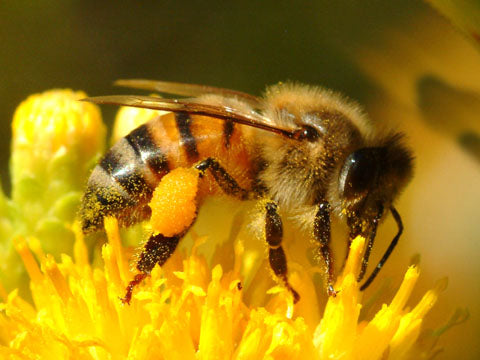
Western Honey Bee a.k.a. The European Honey Bee
The desert native bees you’ll encounter in summer gardens and wild spaces are normally stingless (no pain) and solitary (no swarms). These traits make desert native bees ideal subjects for study by young nature explorers, citizen scientists of any age, and of course the rest us who just like to watch. The key exception to the stingless trait in common desert native bees are bumble bees – see below.
Estimates suggest that up to 1,000 species of native bees reside in the Sonoran Desert (Arizona-Sonora Desert Museum, 2018) and a large portion of these are active in the summer. The vast majority of these bees are very small, however, often no larger than a grain of rice. Still, there are a number of common desert native bees that are large and easy to identify. A selected short list of those bees is provided below. Happy viewing!
 SQUASH BEE: Brownish with a yellow back, facial light spot and dull abdominal striping. Its preferred food sources and nest areas are wild gourds and cultivated squash/pumpkins. SQUASH BEE: Brownish with a yellow back, facial light spot and dull abdominal striping. Its preferred food sources and nest areas are wild gourds and cultivated squash/pumpkins.
|
 BUMBLE BEE: Nearly as large as a carpenter bee, but obviously not one due to the multiple bright yellow hair bands. It has a powerful sting if provoked and aggressively defends its nest. BUMBLE BEE: Nearly as large as a carpenter bee, but obviously not one due to the multiple bright yellow hair bands. It has a powerful sting if provoked and aggressively defends its nest.
|
 CACTUS BEE: Mostly black with a brownish-colored back and prominent white abdominal stripes. It feeds almost exclusively on native cactus species, most notably the prickly pear family and cholla. CACTUS BEE: Mostly black with a brownish-colored back and prominent white abdominal stripes. It feeds almost exclusively on native cactus species, most notably the prickly pear family and cholla.
|
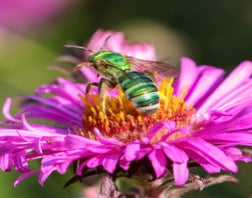 GREEN SWEAT BEE: Small bees with marked abdominal bands. Color can be simple brown or black, or vivid metallic green and yellow. At times, some will seek human sweat. GREEN SWEAT BEE: Small bees with marked abdominal bands. Color can be simple brown or black, or vivid metallic green and yellow. At times, some will seek human sweat.
|
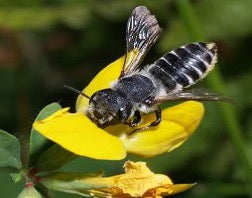 LEAFCUTTER BEE A.K.A. ALFALFA BEE: Small, black bees with prominent abdomen stripes. They cut perfectly round holes in leaves for use in building their above ground tube nests. LEAFCUTTER BEE A.K.A. ALFALFA BEE: Small, black bees with prominent abdomen stripes. They cut perfectly round holes in leaves for use in building their above ground tube nests. |
 YELLOW FACE BEE: Black and almost hairless, with bright yellow facial markings; Pollen and nectar are carried internally back to the nest in their crop, also called a "honey stomach". YELLOW FACE BEE: Black and almost hairless, with bright yellow facial markings; Pollen and nectar are carried internally back to the nest in their crop, also called a "honey stomach".
|
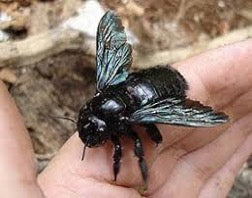 CARPENTER BEE: Very large and jet black, often with yellow markings. They are harmless in almost all cases (just don’t squeeze one!). They often forage along with bumble bees. CARPENTER BEE: Very large and jet black, often with yellow markings. They are harmless in almost all cases (just don’t squeeze one!). They often forage along with bumble bees.
|
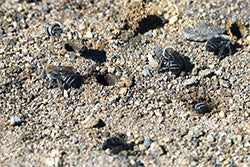 MINING BEE: Black or dull metallic body, but some variants are yellow or white. They nest in sandy soils, often in large colonies, which are evident from the many raised nest entrances. MINING BEE: Black or dull metallic body, but some variants are yellow or white. They nest in sandy soils, often in large colonies, which are evident from the many raised nest entrances.
|
Look for summer bees where they are most likely to be – among flowering plants, shrubs, and trees, plus cacti in bloom. Desert native bees prefer flat-faced flowers in purple, blue, or yellow but they will gather pollen and nectar from whatever is available. Avoid any areas recently treated with pesticides or herbicides, however, as these are killing fields for bees and many other beneficial fauna. Try the Spring Nuturing Mix or the Monsoon Fall Mix For Desert Native Bees available at our store and online to get a plot of flowers going to attract pollinators.
To learn more about desert native bees, attend a workshop sponsored by Native Seeds/SEARCH. These informal sessions provide education and practical examples that empower you to create conditions to preserve and nurture desert native bee populations. Workshop facilitator Bill McGuire is an experienced Arizona gardener and a desert native bee enthusiast. The next Understanding and Nurturing Desert Native Bees workshop is on Saturday July 28th, 2018 at the NS/S retail store in Tucson. Stay tuned for details on our Event Calendar.
